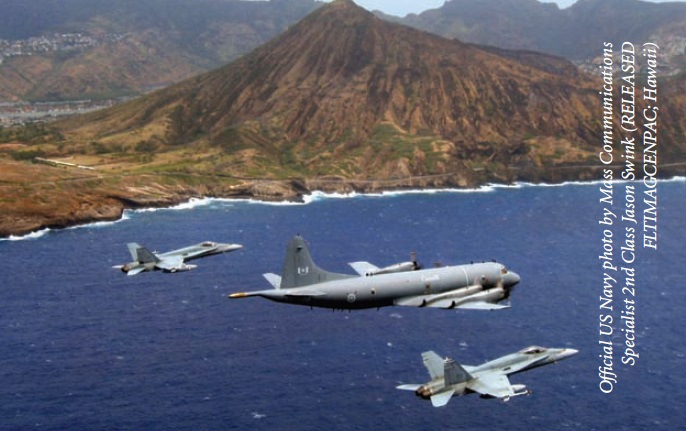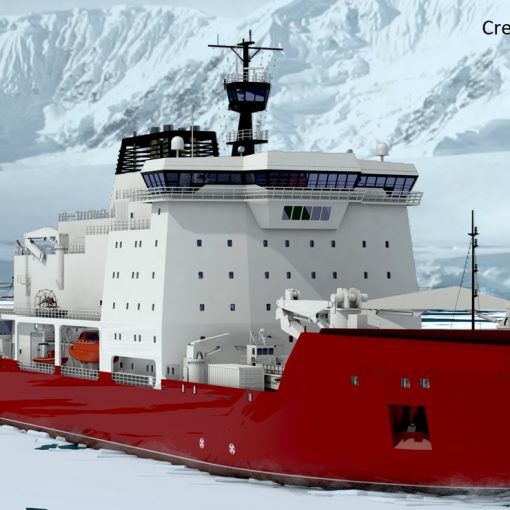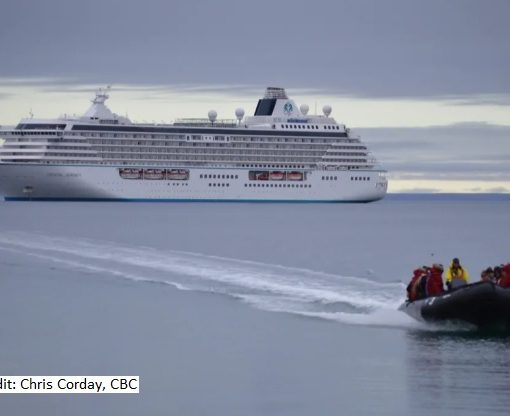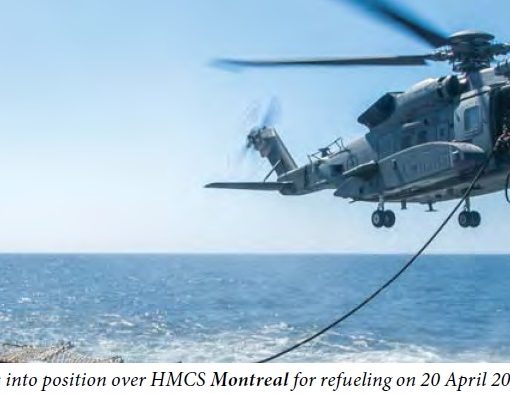The Canadian Forces took delivery of the first CP-140 Aurora maritime patrol aircraft in May 1980; the 18th and last CP-140 was delivered in August 1981. The original requirement for 24 aircraft was unilaterally reduced by the Trudeau government without a commensurate reduction in tasks to be performed. Consequently, the Aurora was employed at roughly twice the rate of similar P-3C aircraft flown by other nations, resulting in reaching its 20,000 hour estimated life expectancy sooner than planned.
By the mid-1990’s, airframe fatigue, obsolescence, and shortage of spare parts for 20-year old electronics led, in 1998, to a modernization program designed to replace most of the Aurora’s avionics and sensors with state-of-the-art systems. The program would not only restore the aircraft’s impressive maritime capabilities but also provide new dimensions in surveillance, reconnaissance and intelligence-gathering. The new Aurora would be a truly national strategic surveillance aircraft capable of operating over land or sea anywhere in the world. Ideally, the new avionics and sensors should have been installed while each Aurora underwent its regularly scheduled third line inspection and repair routine under an omnibus Aurora life extension program. But, because of fiscal considerations the government decided on a phased approach known as the Aurora Incremental Modernization Program (AIMP).
The AIMP is made up of 23 separate projects grouped into four blocks, requiring each aircraft to be processed through the IMP plant in Halifax four times. Currently, up to five aircraft are under modification at any one time. Initially, the estimated cost of the modernization program was approximately $1B. Originally scheduled for completion in 2008, completion has slipped to 2012 and the total cost has escalated to just under $1.5B.
Block 1, which consisted of a number of legacy projects to address regulatory and compliancy deficiencies, has been completed. Canadian Marconi Corporation and Thales Systems Canada have completed engineering for the Block 2 Navigation and Flight Instrument Modernization Project (NFIMP) and the Communication Management System (CMS). All the NFIMP and CMS avionics have been purchased for 18 aircraft and IMP has completed installation for Block 2 avionics on five aircraft.
General Dynamics Canada has completed the engineering design for Block 3, a Data Management System (DMS). The initial DMS avionics have been purchased for testing in the first aircraft. IMP estimates the final DMS installation will be completed by 2012, with the last Aurora being operational in 2013. All of the Block 3 Electronic Support Measures (ESM) and acoustic detection system electronics have been delivered.
Block 4 is the second phase of the DMS modernization and includes upgrades to the Magnetic Anomaly System and installation of a Defensive Electronic Warfare System. Block 4 also affords an opportunity to upgrade avionics installed during previous Blocks and to correct any residual problems.
The AIMP will give the Aurora a superior maritime, arctic, and overland surveillance capability that will be operationally effective for the next two decades. If Canada is to enforce sovereignty over its debated jurisdiction of the North, it will require the capability to exercise a national presence and monitor shipping navigating the Arctic. Currently, the AIMP Aurora is Canada’s only surveillance platform capable of providing these functions year-round. Similarly, its new overland capabilities will relieve Canada of reliance on its allies for strategic surveillance for its expeditionary forces.
Corrosion that compromises the structural integrity of the Aurora’s wings and horizontal stabilizers was found during routine third-line inspection and repair activity. In 2000, a follow on structural assessment program, a shared venture with Norway and other P-3C nations, confirmed a fleet-wide corrosion problem that will render all aircraft unsafe in 2012-2015. An Aurora Service Life Extension Program (ASLEP) will be required to extend the life of Canada’s ‘high mileage’ aircraft until 2025. The cost is estimated at $25M per aircraft, $450M for the fleet. The near $2B total cost for AIMP and ASLEP prompted Air Command to investigate joining the U.S. Navy’s P-8 Poseidon Multi-purpose Maritime Aircraft (MMA) program. This option was rejected in 2005 because the P-8 would not be available to Canada until 2015 – 2020 and because the cost would exceed significantly the combined price for AIMP/ASLEP.
To make saving on personnel and operations, Air Command has already disbanded three squadrons. These savings were quickly consumed by the acquisition of C-17 and C-130J transport aircraft and H-47 Chinook heavy-lift helicopters. These new costs forced a fiscal review of all capital programs. In October 2007, the government suspended the ASLEP and Block 3 of the AIMP.
Meaningful savings in the AIMP will be difficult to realize. Close to $1B of the $1.5B dollars in the program have been spent on non-recurring design and engineering costs and electronics. The only significant remaining cost is installation of the electronics by IMP. DND is faced with the conundrum of having spent close to a billion dollars, to date, on AIMP to make the Aurora’s sensors viable until 2025; but, belatedly found that the Aurora airframe will be airworthy only until the 2012-2015 timeframe.
One obvious solution is to approve the ASLEP. Another less costly option is to reduce the Aurora fleet size and implement AIMP/ASLEP in only 12-16 aircraft. Another option is the acquisition of Unmanned Air Vehicles (UAV’s) to either replace or supplement a reduced Aurora fleet.
The personnel and operations costs for UAV’s are significantly less than for manned aircraft. However, in short, the cost of any UAV depends on the range and altitude at which it is required to operate and the sophistication of the surveillance sensors to be employed. While some UAV’s can remain aloft for 24 hours, trials have indicated that they have difficulty coping with severe winter weather over the North Atlantic and North Pacific and they have yet to demonstrate any capability in the Arctic. UAV’s are also slower (250 knots), resulting in reduced responsiveness. UAV’s also have no underwater surveillance capability. Compared to the Aurora, the UAV’s greatest disadvantage is its inability to spontaneously react to multiple targets and to assume an on-scene command and control role with cooperating forces. A UAV’s mission flexibility, the ability to re-task it in flight, is dependant upon sophisticated guidance and control links to geo-synchronous satellites. Additionally, satellites supporting UAV operations require sufficient bandwidth to down-link surveillance imagery to a ground station for real-time analysis. UAV cost versus benefit analyses will have to include the acquisition and operation of a compatible Canadian satellite(s) or the user fees to access allies’ satellites with the required specialized capabilities.
The U.S. Navy has addressed its expanding surveillance requirements by developing a world-wide Broad Area Maritime Surveillance (BAMS) capability. The P-8 MMA and UAV’s are two of the fundamental components of BAMS. The UAV’s will operate from five locations around the globe to provide persistent (up to 30 hours continuously) surveillance over ocean areas and littoral waters of interest; while the P- 8’s will fly from the current USN air bases around the world to provide the maritime patrol and response roles for targets of interest, including underwater surveillance.
Canada has the option of meeting its future surveillance needs by following Australia’s lead and joining the BAMS program. Canada would require its own aircraft with the capabilities of the AIMP Aurora and a small fleet of suitable UAV’s. If, as a result of the fiscal review, the government decides to clip the Aurora’s wings by not pursuing Block 3 of the AIMP and some form of a ASLEP, then a new aircraft, such as the P-8, will be required.
The Canadian government appears to have two options to maintain a national surveillance capability. It can continue with the AIMP and take advantage of the nearly $1B already spent and commit to a structural life extension program. This will keep the Aurora viable until 2025, when a new aircraft will be required. Its second option is to cancel the AIMP, absorb the costs already expended, pay the cancellation penalties, and attempt to stretch the Aurora’s life expectancy to the 2015 – 2020 timeframe. The savings could be applied towards a new aircraft, such as the USN’s P-8. This would have the advantage of being BAMS compatible and having a life expectancy to at least 2045.
Regardless of the decision taken, Canada cannot afford to have a surveillance gap between the end of the current Aurora capability and its successor. The lack of surveillance over national areas of interest would not only jeopardize Canadian sovereignty but also result in a loss of a perishable expertise in surveillance.





